Muitos blogueiros começam sua jornada no Blogger por ser uma plataforma gratuita e simples. No entanto, à medida que seu blog cresce, você pode começar a se sentir restringido por seus recursos limitados.
A mudança para o WordPress pode abrir um mundo de possibilidades com seus amplos recursos. Mas há uma preocupação comum sobre essa mudança: a possível perda de classificações no Google.
Este artigo o guiará pelo processo de transição do Blogger para o WordPress. Vamos nos concentrar em como fazer isso corretamente, garantindo que você mantenha intactas as suas valiosas classificações no Google.
Nosso objetivo é ajudá-lo a atualizar sua plataforma de blog sem sacrificar os esforços de SEO que você já dedicou ao seu site.
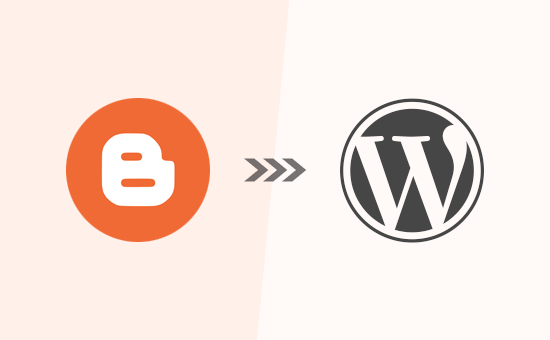
Por que mudar do Blogger para o WordPress?
O Blogger é uma plataforma de blog popular criada pelo Google. Ela permite que qualquer pessoa crie um blog gratuito usando sua conta do Google.
Entretanto, muitos iniciantes logo percebem que há muitas limitações no que podem fazer com o blog gratuito do Blogger.
O WordPress, por outro lado, dá a você total propriedade do seu site. Ele também permite que você adicione os recursos necessários para expandir seu blog e monetizar seu conteúdo. Além disso, você pode realizar todas as otimizações de SEO para obter uma classificação mais elevada. Criamos uma comparação detalhada lado a lado entre o WordPress e o Blogger.
É importante observar que, quando falamos em WordPress, estamos nos referindo ao WordPress.org auto-hospedado, que NÃO deve ser confundido com o WordPress.com, que é uma solução hospedada que tem suas próprias limitações. Para obter detalhes, consulte nosso artigo sobre a diferença entre WordPress.com e WordPress.org.
O WordPress.org é a popular plataforma “WordPress” sobre a qual você provavelmente já ouviu falar, pois ela alimenta 43% de todos os sites da Internet.
Dito isso, vamos dar uma olhada em como mudar corretamente do Blogger para o WordPress e, ao mesmo tempo, preservar as classificações de pesquisa do Google e o tráfego do site.
Aqui estão as etapas que usaremos para transferir do Blogger para o WordPress:
Pronto? Vamos começar.
Tutorial em vídeo
Se não quiser assistir ao tutorial em vídeo, você pode continuar lendo a versão em texto abaixo.
Etapa 1: Inscreva-se na hospedagem do WordPress
Para começar a usar o WordPress, você precisará de um nome de domínio e de hospedagem na Web.
Para relembrar, um nome de domínio é o endereço do seu site que as pessoas digitam para acessar seu blog, e a hospedagem na Web é onde os arquivos do site são armazenados. Ambos são OBRIGATÓRIOS para criar qualquer tipo de blog ou site.
Dito isso, recomendamos o uso da Bluehost. Ela é uma das maiores empresas de hospedagem do mundo e é um parceiro de hospedagem WordPress oficialmente recomendado.
Como o WPBeginner é o maior site de recursos do WordPress, eles concordaram em oferecer aos nossos leitores um nome de domínio gratuito e um desconto de 60% na hospedagem. Basicamente, você pode começar a usar o site por apenas US$ 1,99 por mês.
Se, por algum motivo, você preferir uma alternativa à Bluehost, recomendamos usar o SiteGround ou o Hostinger, pois ambos são excelentes soluções.
Depois de se inscrever no plano de hospedagem do WordPress e configurar seu nome de domínio, você pode avançar para a etapa de instalação do WordPress.
Se você se inscrever na Bluehost usando nosso link acima, eles instalarão o WordPress automaticamente para você.
Se você usou um provedor de hospedagem WordPress diferente, precisará instalar o WordPress seguindo nosso guia definitivo sobre como instalar o WordPress.
Depois de instalar o WordPress, é hora de mover seu conteúdo do Blogger para o WordPress.
Oferta gratuita de bônus: Como muitos de vocês pediram isso, agora estamos oferecendo um serviço gratuito de migração do Blogger para o WordPress como parte do nosso serviço gratuito de configuração de blog no WordPress. Isso significa que um dos membros da nossa equipe de especialistas fará toda a migração para você (100% grátis). Sim, você pode literalmente mudar do Blogger para o WordPress sem nenhum risco.
Observação: Nosso serviço gratuito de migração para o Blogger destina-se a blogs menores, com menos de 1.000 publicações. Podemos oferecer um serviço de migração para sites maiores do Blogger, mas esse será um serviço pago.
No entanto, se você gosta de aprender e fazer as coisas por conta própria, siga nosso tutorial passo a passo abaixo.
Etapa 1: Exportar seu blog do Blogger
A primeira coisa que você precisa fazer é exportar o conteúdo do seu blog do Blogger.
Você pode fazer isso visitando o site do Blogger e acessando o painel de controle da sua conta.
Depois disso, vá para a página Settings (Configurações ). Role para baixo até a seção “Manage Blog” e clique no botão “Back up Content”.
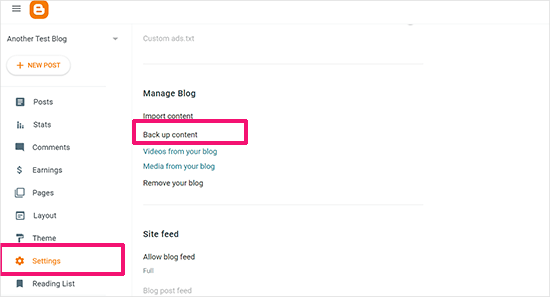
Isso abrirá uma janela pop-up mostrando o que exatamente está incluído no backup do Blogger.
Você precisa clicar no botão “Download” para continuar.
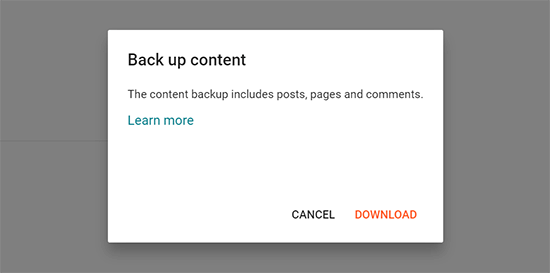
O conteúdo do seu blog do Blogger será baixado para o seu computador em um arquivo XML.
Quando o download estiver concluído, é hora de importar o conteúdo do Blogger para o site do WordPress.
Etapa 2: Importar o Blogger para o WordPress
Para começar a importar seu site do Blogger para o WordPress, faça login na área de administração do WordPress e acesse Ferramentas ” Importar.
Na página Import, vá em frente e clique no link “Install Now” (Instalar agora) abaixo do Blogger.
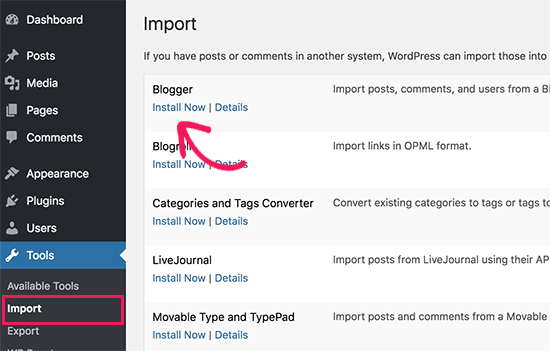
O WordPress fará o download e instalará o plug-in Blogger Importer para você.
Quando a instalação estiver concluída, você precisará clicar no link “Run Importer” (Executar importador) para continuar.
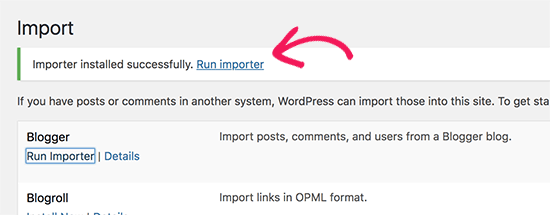
O WordPress solicitará que você carregue o arquivo XML na tela Importar Blogger. Esse é o arquivo que você baixou na Etapa 1.
Basta clicar no botão “Choose File” e carregar o arquivo XML que você baixou anteriormente.
Em seguida, clique no botão “Upload file and import” (Carregar arquivo e importar) para continuar.
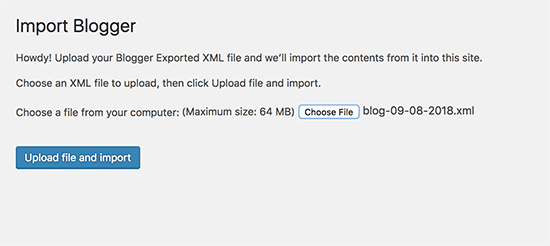
O WordPress agora fará o upload do arquivo de importação. Se o arquivo de importação for muito grande, você poderá ver uma mensagem de erro.
Nesse caso, você precisará aumentar seu limite máximo de upload de arquivos. Se o arquivo for pequeno, você não verá nenhum erro.
Em seguida, você será solicitado a atribuir postagens a um autor. Se você tiver vários autores no blog do Blogger, poderá criar uma nova conta de usuário para cada autor. Você também pode atribuir essas postagens a autores existentes em seu site do WordPress.
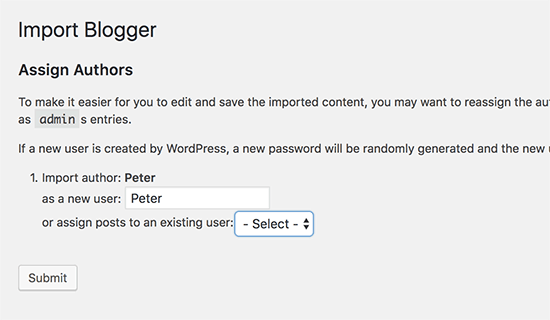
Depois de fazer sua seleção, clique no botão “Submit” (Enviar) para continuar.
O WordPress importará todo o conteúdo do arquivo de exportação do Blogger para o seu site WordPress. Você pode visualizar o conteúdo visitando a página Postagens ” Todas as postagens.
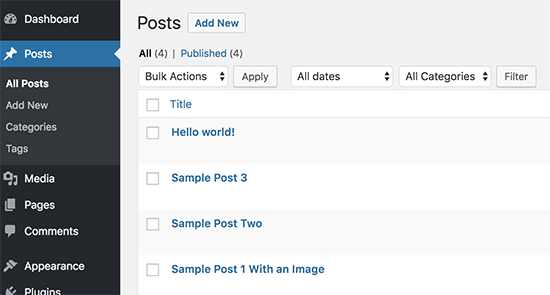
Etapa 3: Configuração de Permalinks
Permalinks é o termo usado para a estrutura de URL de páginas individuais. O WordPress vem com um recurso que permite que você configure uma estrutura de URL amigável para SEO.
Como você está importando conteúdo do Blogger, é necessário que a estrutura de URL seja a mais próxima possível da estrutura de URL do site antigo do Blogger.
Para definir permalinks, você precisa ir para Configurações ” Permalinks no painel do WordPress e escolher a opção “Estrutura personalizada”.
Depois disso, você precisa adicionar o seguinte texto na caixa ao lado do campo de estrutura personalizada:
1 | /%year%/%monthnum%/%postname%.html |
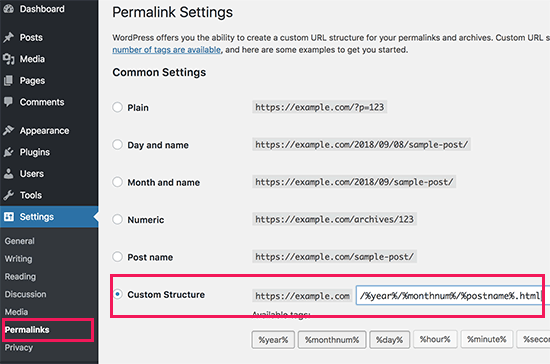
Essa estrutura de permalink torna os URLs das postagens do seu blog semelhantes aos URLs do seu antigo blog do Blogger.
No entanto, às vezes o URL da postagem do seu blog, também conhecido como slug no WordPress, não corresponde aos slugs usados pelo Blogger.
Para corrigir isso, você precisará criar e executar um pequeno trecho de código.
Recomendamos adicionar esse código PHP usando o plug-in WPCode. Essa é a maneira mais segura de adicionar código personalizado ao seu site WordPress. Para obter mais detalhes, consulte nosso guia sobre como copiar e colar trechos de código no WordPress.
1 2 3 4 5 6 7 8 9 10 11 12 13 14 | add_action( 'init', 'wpb_update_slug' );function wpb_update_slug() {global $wpdb;$result = $wpdb->get_results("SELECT post_id, meta_value FROM $wpdb->postmeta WHERE meta_key = 'blogger_permalink' ");$wpdb->print_error();foreach ($result as $row){$slug = explode("/",$row->meta_value);$slug = explode(".",$slug[3]);$wpdb->query("UPDATE $wpdb->posts SET post_name ='$slug[0]' WHERE ID = '$row->post_id' ");}echo "DONE";} |
Depois de salvar o código, basta visitar qualquer página do seu site WordPress para acionar esse script.
Importante: depois que o script for executado, não se esqueça de desativá-lo ou excluí-lo da biblioteca do WPCode, pois ele só precisa ser executado uma vez.
Oferta de bônus grátis: Não quer lidar com códigos? Nós ajudamos você. Como muitos de vocês pediram isso, agora estamos oferecendo um serviço gratuito de migração do Blogger para o WordPress como parte do nosso serviço gratuito de configuração de blog no WordPress.
Isso significa que um dos membros da nossa equipe de especialistas fará toda a migração para você (100% grátis). Sim, você pode literalmente mudar do Blogger para o WordPress sem nenhum risco.
Etapa 4: Configurar redirecionamentos do Blogger para o WordPress
A etapa mais importante na migração de qualquer site é configurar o redirecionamento adequado para que você não perca nenhum tráfego existente ou classificações de SEO. Para obter mais detalhes, consulte nossa lista de verificação definitiva de migração de SEO para WordPress.
Observação: Se o seu blog do Blogger tiver seu próprio domínio personalizado em vez de blogspot.com, talvez seja necessário apontar os nameservers do domínio para o provedor de hospedagem. Para obter instruções, siga nosso tutorial sobre como mudar o domínio personalizado do blogger para o WordPress.
A parte crucial do redirecionamento é garantir que seus usuários cheguem à mesma página no novo domínio que estavam tentando acessar no site antigo.
Ao mesmo tempo, você também precisa garantir que os mecanismos de pesquisa entendam que seu site foi movido para esse novo local.
Para isso, você precisa instalar e ativar o plug-in Blogger to WordPress Redirection. Para obter mais detalhes, consulte nosso guia passo a passo sobre como instalar um plug-in do WordPress.
Após a ativação, você precisa visitar a página Tools ” Blogger to WordPress Redirection e clicar no botão “Start Configuration” (Iniciar configuração).
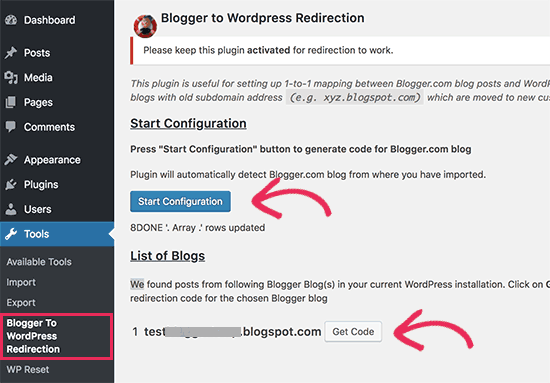
O plug-in agora detectará o URL do seu blog do Blogger e mostrará a opção de obter um código de redirecionamento. Vá em frente e clique no botão “Get Code” ao lado do URL do Blogger.
Agora, ele gerará um trecho de código necessário para redirecionar adequadamente os usuários do seu antigo blog do Blogger para o seu novo site do WordPress.
Em seguida, você precisa fazer login no painel do Blogger e ir para a página “Temas”. Clique na seta suspensa do botão “Personalizar” ao lado do seu tema e selecione a opção “Editar HTML”.
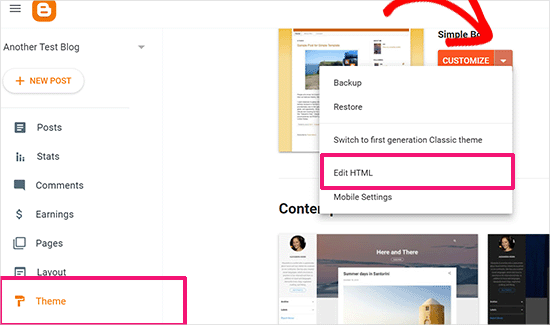
O Blogger agora exibirá o código HTML personalizado para o modelo do seu tema. Se você tiver feito alguma personalização no tema do Blogger, talvez queira copiar o código e salvá-lo no computador como backup.
Caso contrário, você pode simplesmente ir em frente e excluir tudo. Depois disso, copie o código exibido pelo plug-in em seu site do WordPress e cole-o no editor de temas do Blogger.
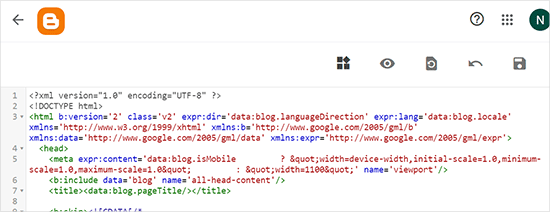
Não se esqueça de clicar no botão “Save theme” (Salvar tema) para armazenar suas alterações.
Em seguida, precisamos configurar redirecionamentos para usuários móveis.
Você precisa voltar à página Temas no painel do seu blog do Blogger. Dessa vez, você precisa clicar no botão de engrenagem abaixo da visualização móvel do seu blog.
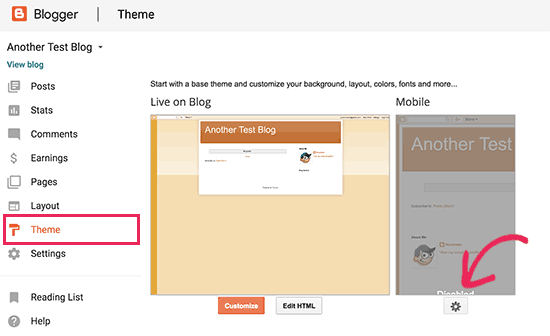
Isso abrirá uma janela pop-up na qual você deverá selecionar a opção “No. Show desktop theme on mobile devices”.
Em seguida, clique no botão “Salvar”.
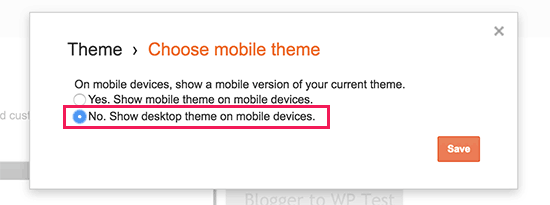
Isso é tudo, seu blog do Blogger agora redirecionará todos os visitantes do blog para seu novo blog do WordPress.
Como alternativa, você também pode usar o All in One SEO (AIOSEO) para redirecionar posts e páginas do Blogger para o WordPress. O plug-in oferece um poderoso recurso de gerenciamento de redirecionamento que permite configurar redirecionamentos completos para o seu novo site.
Além disso, você pode ativar o rastreamento de erros 404 e capturar quaisquer links quebrados que possam ocorrer ao mover seu site para o WordPress. Isso ajudará a melhorar a experiência do usuário e você não perderá classificações de palavras-chave.
Etapa 5: Como mover outros conteúdos do Blogger para o WordPress
Nesta etapa, moveremos o conteúdo restante do blog antigo no Blogger para seu novo blog do WordPress. Isso pode exigir algum trabalho manual, dependendo das configurações/conteúdo de seu blog.
1. Como mover páginas do Blogger para o WordPress
A ferramenta de importação do Blogger do WordPress importa apenas as postagens do Blogger e ignora as páginas.
Para mover suas páginas para o WordPress, você terá de editar cada página em seu blog do Blogger, copiar o conteúdo e criar manualmente uma página no WordPress.
Para saber mais sobre páginas, consulte nosso artigo sobre a diferença entre posts e páginas no WordPress.
Agora, você se deparará com outro problema. As páginas do Blogger têm URLs parecidas com esta:
http://example.blogspot.com/p/about-us.html
O URL de sua página do WordPress terá a seguinte aparência:
http://example.com/about-us
Para corrigir isso, você precisará usar o plug-in All in One SEO (AIOSEO). Para obter instruções, consulte nosso guia para iniciantes sobre a criação de redirecionamentos no WordPress.
2. Widgets
Assim como o Blogger, alguns temas do WordPress também utilizam widgets para adicionar conteúdo à barra lateral do seu blog.
Para adicionar widgets, você precisa visitar a página Appearance ” Widgets no painel do WordPress e simplesmente arrastar/soltar os widgets nas barras laterais. Para obter instruções detalhadas, consulte nosso guia sobre como adicionar e usar widgets no WordPress.
Se você estiver procurando por um widget específico que não é exibido no WordPress por padrão, provavelmente precisará de um plug-in do WordPress. Você pode pesquisar a categoria de melhores plug-ins do WordPress do WPBeginner para encontrar a funcionalidade que deseja.
3. Feeds RSS
Os mecanismos de pesquisa e os usuários que assinam as publicações do seu blog por meio de feeds RSS ainda poderão encontrar o seu blog. No entanto, eles não receberão nenhum conteúdo novo.
Para corrigir isso, visite a página Configurações em sua conta do Blogger. Em seguida, role para baixo até a seção “Site feed” e clique em “Post feed redirect URL”.
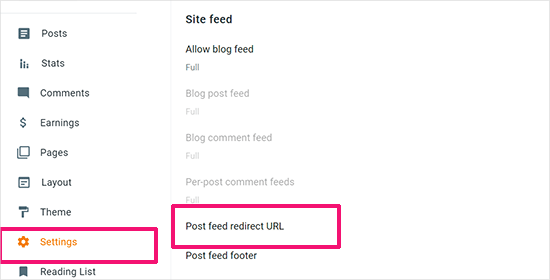
Isso abrirá uma janela pop-up na qual você precisará adicionar o URL do feed RSS do seu site WordPress.
Seu URL de feed do WordPress terá a seguinte aparência:
http://example.com/feed
Não se esqueça de substituir example.com por seu próprio nome de domínio.
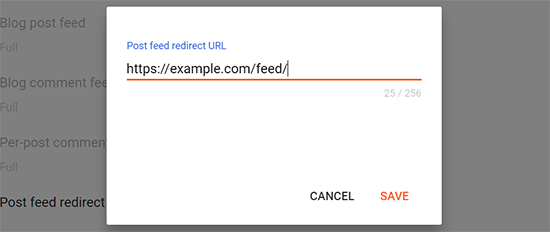
Clique no botão “Save” (Salvar) para adicionar o URL e salvar suas configurações.
Etapa 6. O que fazer depois de migrar do Blogger para o WordPress
Agora que você transferiu com sucesso o seu blog do Blogger para o WordPress, vamos dar uma olhada no que mais você pode fazer para melhorar o seu blog.
Criamos uma lista de verificação das coisas mais importantes que você precisa fazer depois de instalar o WordPress.
O WordPress é muito fácil de usar. No entanto, você ocasionalmente descobrirá coisas novas com as quais poderá precisar de ajuda. É aí que entra o WPBeginner.
O WPBeginner é o maior site de recursos gratuitos para WordPress do mundo. Publicamos regularmente tutoriais e guias escritos especificamente para blogueiros e pequenas empresas.
Aqui estão alguns dos recursos úteis que você encontrará no WPBeginner (todos eles são gratuitos):
- WPBeginner Blog – O local central para todos os nossos tutoriais e guias do WordPress.
- Dicionário WPBeginner – Nosso glossário do WordPress é o melhor lugar para se familiarizar com o jargão do WordPress
- Vídeos WPBeginner – Novos usuários do WordPress podem começar com esses vídeos passo a passo para dominar o WordPress.
- WPBeginner no YouTube – Precisa de mais instruções em vídeo? Inscreva-se em nosso canal do YouTube com mais de 291.000 assinantes e mais de 50 milhões de visualizações.
- WPBeginner Blueprint – Confira os plug-ins, as ferramentas e os serviços que usamos no WPBeginner.
- WPBeginner Deals – Descontos exclusivos em produtos e serviços WordPress para usuários do WPBeginner.
Esperamos que este artigo tenha ajudado você a mudar do Blogger para o WordPress sem afetar suas classificações de pesquisa no Google. Talvez você também queira ver nosso guia sobre qual plano do WordPress você deve usar ou os mitos mais comuns do WordPress desmascarados.
Se você gostou deste artigo, inscreva-se em nosso canal do YouTube para receber tutoriais em vídeo sobre o WordPress. Você também pode nos encontrar no Twitter e no Facebook.





Mini
This useful even for moving free blog on blogspot to free blog on wordpress?
And will it transfer previously received comments too?
Katheriine
I have a problem with all of my pinterest pins stopping at a blogger page saying “this blog is no longer hosted by blogger do you wish to be redirected?” and you have to choose yes or no and obviously people usually just exit out or hit no so it’s killing my page views. Any help??
Susann
I don’t have the export blog (or import) button on my blogg. Only the Delete button. Did they take this away, how can I export my blog now? Or do I need to change anything somewhere else to get it to show up?
Eli
Hi, I don’t can’t use permalinks with /month/day, i need to use /blog-post-title.
is there a way to modify the php code, to get a proper redirect?
WAHEED HABIB
Dear Author, thank u so much for such a great help in transferring blogger data to wordpress theme. But redirection woud;nt work for me rather i use simple Blogger to WordPress Redirection plugin a very simple and easy to use tool i just love it. I have redirect my blogger site to WordPress.
Mallory
Hi! Thank you so much for this helpful guide!!
I’ve done everything as you explained and redirection works but I get this message on top of my wordpress: Notice: Undefined index: blogger in /var/www/vhost/example/home/html/wp-content/themes/betheme-child/functions.php on line 94
I therefore went and checked line 94 and this is the one: $blogger = $wp_query->query_vars[‘blogger’];
would you be able to help me?
Thank you so much
Patricia
Hi, currently trying to follow your instructions but I keep getting this message when I try to save the blogger redirection code in reference to the blog page title line.
“Error parsing XML, line 3, column 9: The content of elements must consist of well-formed character data or markup.”
Please help?
JC
Glad i found this. I’ve been so afraid to move my blog from blogger to W/P. One question: Do my followers on blogger also go with me?
Also, is there a way (don’t know what it’s called) to let those that come to your blogger site know that you’ve moved to W/P?
WPBeginner Support
If by followers you mean those who used Google ID to follow your blogger blog, then no.
Yes, using this method, people arriving at your blogger site through other sources will be properly redirected to your new site.
Admin
Lindsey
So helpful. However, when I refresh after all the steps, I get the 2nd code we pasted showing at the top. Am I missing something? It is even showing in my WP Admin dashboard!!
WPBeginner Support
It seems you pasted the code after a closing ?> php tag. You can paste the code again before the closing php tag or add this tag at the beginning of the code
<?phpAdmin
Katelyn
I am having the hardest time converting from BlogSpot to Word Press. For some reason I don’t know if it’s the browser I’m using or what but when I go to Settings –> Other —> to import and backup or backup content (those are the only two options it give me) I don’t have an export blog option. I’m getting ready to just freakin pay someone to do it!
Huda
What about the design theme? can I change it to wordpress theme?
Sy Abuzar
Hello. Brother.
This is Very Useful Article Amazing and Mind Blowing Guidelines Step by Step, I like It Thanks a lot,
Have a Nice Day Ahead
Febriyan
I had tried all the steps there and if I opened my blogspot blog on my computer, it worked just fine. It redirected automatically to the new domain on wordpress. But if I use my phone or asked my friend to access the blogspot, it didn’t do anything. No redirection at all.
Can you help me on this?
my blogspot is
Erin
Thank you for your post, super easy to follow and felt confident importing my blog. Though alas and alack I had trouble with the images, they didn’t import. I then followed your extra assistance for that scenario but whilst some imported to media library, some didn’t, and none are showing as featured images.
Any tips would be greatly appreciated.
collins
Thanks it helped,,Please i’ll love to talk 2 privately here is my mail address.
WPBeginner Support
Please use our contact page to send us private mail.
Admin
Mercedes
Thank you! This was super helpful.
Having a little trouble with the second code though. I have no idea how to even access the file I need to paste the code into?
WPBeginner Support
It goes in your theme’s functions.php file. Go to Appearance page in your WordPress admin area, and note the name of your active theme. Connect to your website using an FTP client, go to /wp-content/themes/your-active-theme-folder/ and there you will find functions.php file. Download it to your computer and open it with a plain text editor like Notepad. Paste the code at the end of this file. Save the file and upload it back to your theme folder using FTP.
Admin
Biz Harris
oh gosh, this was super helpful, but ONE note… maybe in the section about entirely changing the blogger code, be SUPER specific that you should change every “http://example.com” to your blog address AND that “www” beforehand isn’t necessary. I tried several iterations before I got this to work for me (and had a couple of panic attacks in the meantime.) anyway, thanks again from this VERY novie workpress beginner!
anyway, thanks again from this VERY novie workpress beginner!
Nicole
This was such a helpful blog post. So many people offer too much information or not enough, but you walked me straight through it! Thank you! I used Thad’s advice to get the mobile views to redirect. That worked.
My only problem now is that I can’t get my “pages” to redirect. They didn’t export/import, so I created new pages, with new names. Can I redirect these 15 pages manually in some way? or at least have a user redirected to my new home pages? Right now they are getting the message that “page you were looking for…does not exist.”
Thank you again! You have been so helpful!
Jwphoto
I’m having this same issue. When I google my blog name these old blogger pages (these were my menu items, not posts) show up. I can’t find a way in blogger to change the url. Is there a way to redirect these individual pages or change their url? Deleting these blogger pages would be bad for SEO, right?
Pascale
Hello, can you confirm where we should paste the 2nd code in function.php? I have read the Beginner’s guide to pasting snippets from the web into wordpress and it is still not clear.
Thank you so much for your help!
WPBeginner Support
It needs to go in your WordPress theme’s functions.php file. You can paste it at the very end of that file.
Admin
Vinayak SP
Above code not worked fully until you do this :
Configure Permalinks on New WordPress
From WordPress Dashboard, go to Settings -> Permalinks and select Custom Structure option and paste the following value next to it and save changes.
/%year%/%monthnum%/%postname%.html
Jas
Hello Syed,
1.
a) I notice in this article you specify the Permalink Settings as follows.
“choose Month and Name”
b) However in your How to “Move Custom Domain Blogger Blog to WordPress” your specify Permalink settings differently in custom format.
“/%year%/%monthnum%/%postname%.html”
2. I did not see the second article until I had already done the migration. I used a) above, then after the migration was complete, I changed it to b) above.
Why the difference between the two? Did I create a problem by beginning with a) then changing to b)? The Google search links seem to link correctly from old posts to new. Is there another factor I am not considering?
Thanks for your time,
Jas
urgent, priority
Tawnya
I have a question on where you copy the 2nd code on redirecting to wordpress do I just copy the code at the bottom of the functions.php file or is there a specific place on that page to copy the code??
Tawnya
I understand all of this except where do I paste the code in wordpress when you say this?
***However, you still need to setup redirection on your WordPress site so that users are redirected to the proper posts.
You need to copy and paste the following code in your WordPress theme’s functions.php file***
Do I just copy that code you provided at the bottom of this section on my wordpress or do I need to make sure it goes in a specific spot??
I hope that makes sense. Thanks for this tutorial
WPBeginner Support
Yes you need to copy the code in the bottom section and then paste it in your WordPress theme’s functions file. Check out beginners guide to pasting snippets from the web into WordPress
Admin
Tawnya
Where in the functions.php do I copy the second code though? I am still confused where that code is supposed to go?
Zara
I can’t find tools or anything in wordpress. Did they update it?
WPBeginner Support
Nope.
Admin
Amy Hunt
I can’t find tools in WP either..Publish, Personalise,Configure those are the only categories?
Lyssa
Thank you for this helping tutorial
i have been read almost full of your blog it’s very informative and helpful
WPBeginner Support
Thanks for the kind words.
Admin
Carla Mota
You are the best!! Thanks
Millo Magnocavallo
Add to previous comment …
I just looked at the source version of the text that’s been imported and in some cases the img tag is appearing like this:
for some reason it’s not printing out the src?
Paul Wentzell
This happens for me, also. I do see that the images for those posts downloaded to the site directory, but it’s curious why they were not inserted into the src of the post.
Millo
Hey! Thank you so much for a great tutorial / how-to. It worked really well, only that I’ve noticed that some images are not appearing in the imported blog posts. Do you have any idea why that might be?
Sharaj Khan
what about blogger to blogger ??????
Sam
easy, just backup template and then upload it on the other blog
Olsi
I followed this guide and it worked very well, but I did a redirect test and it says 302 Moved Temporarily and not 301 as it should be.
I`m I doing something wrong? Anybody else did a redirect test?
Paul
I’m also seeing a 302 from any redirect checker tool I am using. All links are indeed redirecting correctly, but 302 is making me uneasy.
Gianluca
Hi, is it possible to import only several posts from the older blog, instead the entire blog?
Thales
I found a work around…
I have replaced the code (line 11):
window.location.href=”http://example.com/?blogger=”
by the following 3 lines:
var str = “”;
var url_old = str.substr(7);
window.location.href=’http://pequenospelomundo.com.br/?blogger=’+url_old;
It works fine and seems that I have kept my google rankings.
Joel
I’m considering this option but am getting stuck on step #1. When I export an xml file from Blogger, the resultant file only includes 200 of my 1030 posts. Why? And what can I do to actually back up ALL of my blog.
Wordpresser
Do you still need to redirect the blogger blog to the wordpress domain if the URL structure including domain, date, article name and .html ending of the URL will all be exactly the same on WordPress as they are on Blogger?
Shelly
I have downloaded the blogger blog and am trying to import the file. It appears to be uploading but then I get the following error: Warning: Invalid argument supplied for foreach() in /home/content/p3pnexwpnas06_data02/87/2994987/html/wp-content/plugins/blogger-importer/blogger-importer.php on line 227
The blogger blog has almost 2,000 posts. Could the size be the problem? I’m afraid I am a complete newbie and am following directions step-by-step.
Kinshuk
Hi,
I am facing the similar issue to Shelly where I am getting following error:. I have around 2000 posts in blogger xml.
Regards.
Emilie
Thank you so much for such an informative and helpful video! I am totally a code newbie, but with your fantastic instructions, even I was able to get my blogger account to automatically send viewers over to my new domain. I only have one problem– and I think it has to do with the second set of code you had me post into the when the function.php file in wordpress. Rather than redirecting users to the specific article that they are attempting to reference in blogger, it just redirects to my entire, overall website. How can I fix it so that users who are clicking on old pinterest pins, etc, receive the recipe that they are looking for, rather than just a generic site where they have to search for the recipe they want? Thanks.
Fachreza
this is legal for blogger and wordpress ???
Michelle Dear
Yes. You own your data. You have the right to port it between tools.
Jericho
Thanks for this tutorial. I have a question, I am using custom domain in my blogger blog and this is the same domain I am going to use in WordPress. Do I have to disconnect the custom domain first and use the “blogspot.com” before heading to migration of my blog? If so, this will affect on my google rankings?
WPBeginner Support
Please see our guide How to move custom domain blogger blog to WordPress
Admin
Julia Taylor
Do you advise deleting the old blogger blog once the site is redirecting properly? Or should we wait for a certain period (if so, how long?)? Or is it best to leave it up for any reason?
WPBeginner Support
It is a free blog, why delete it if its not hurting your rankings? But if you must delete it, then we would recommend waiting for at least 6-12 months.
Admin
Julia Taylor
Well I guess I am not 100% confident we aren’t going to get hurt for duplicate content, since we are still seeing activity in the “Stats” tab. How do I test to make sure that is not going to happen?
Jason Booth
The 301 redirect and canonical tag should alleviate the fear about duplicate content but what I’ve found that this technique is not redirecting mobile traffic.
Mobile users are getting a different template on Blogger and not being redirected to the new site. I’ve been looking into it but have yet to find how to disable or change the template served to mobile devices.
Thales
I had the same issue (mobile users still accessing blogger). I have disabled mobile version in blogger and works fine.
Log in to blogger; go to template; click ‘update template’; on the top of the page you have the mobile preferences. Click and disable mobile version; then click back in ‘Revert to classic template’ – Done!
Julia Taylor
I am glad Jason pointed out the issue that mobile users are not being redirected. Can you guys please help us figure this out? I need the blog posts on mobile to also be redirecting to the new site, which they are not.
Julia Taylor
Oops, I missed the comment from Thales. Just did that, and it appears to be working. Thank you Thales!
Jason Booth
Thanks, Thales! Fixed it for me as well.
Julia Taylor
I followed all your instructions and everything seems to be working just fine, but we are still seeing some page views in the old Blogger site’s stats tab. Is it tracking the pages/posts that are redirecting to the new self-hosted WP site? Or is something not set correctly?
WPBeginner Support
Your blogger blog is not just visited by humans but also by many bots, crawlers, automated scrips, etc. Some of these bots may request a cached version of your blog this will generate a page view in Blogger’s stats. You can see the device information in your stats tab for that particular day.
Admin
Samantha
I’m trying to redirect my blog to my new wordpress site, but I’m turning all my blog posts into knowledge base articles.
How would I modify the code so that oldblog.blogspot.com/month/day/postname redirects to example.com/knowledgebase/postname
The “/knowledgebase” part is automatically added by the plugin I’m using and is not part of the permalinks structure.
WPBeginner Support
You can switch the post type to knowledgebase. We are not sure what kind of affect it will have on redirects. Its best if you test it on a local install with demo blogspot blog first.
Admin
Ketan
This was probably the easiest explanation of migrating from blogger to WP that I found till date. Thanks for posting. The redirect bit – that is something to do carefully.
Kim Brookes
I wrote a bit ago. You should probably ignore what I wrote because for some reason now it’s working. It’s either working now because I copied the snippet for the blogger template again, and changed the “example.com”s again. Or, because the links embedded on my WP site posts (that were ported from blogger) still have the blogger URLs, which WP interprets by substituting .blogger.com with my.new.url, which goes 404 on WP.
That is, in case it’s helpful, the post that was on blogger, now WP:
included a link in the text to
which somehow in the migration, or me doing something wrong, got changed into
and that’s a URL that doesn’t exist (WP with a .html instead of /)
So, mostly thanks for your awesome site. And ignore my previous comment.
-Kim
WPBeginner Support
We are glad you successfully migrated your website.
Admin
Kim Brookes
Awesome site you have here! I’ve used all sorts of the articles.
I’ve followed all of the instructions on this “how to switch” page. Most of it is working, but the old links on Blogspot aren’t redirecting to my new domain. They’re going to a 404. This is because the old blogspot URLs end in .html, and the new WordPress URLs end with the post_title/
as though it’s a directory instead of old-fashioned .html file. I think the issue is with the WP function code, but I don’t know the coding well enough to guess at how to make WP redirect to a (delete the slash, add “.html”) URL.
Nor do I know how to add the coding to the WP permalink page. I don’t want to mess with this, though because I don’t want “.html” added to all of my new posts. For now, the only think I can think to do is to change the permalink individually on all of my migrated-to-WP blogspot posts. Yuck.
Thanks for any help you can provide.
Julia Taylor
Thank you SO MUCH for this post…it really helped me! I do have a question. Is it possible to redirect the main blog address to a page on the site? The reason I am asking is because the new blog is just part of site, and redirecting blog reader to the homepage might be confusing. So can can I redirect example.blogspot.com to http://www.example.com/blog/, instead of http://www.example.com? I am a little nervous to go messing with your beautiful redirect code as I do not want to mess it up! Thanks so much!!!
WPBeginner Support
Yes, you can do that.
Admin
Christene
Before I begin doing this, I need to know something: Once all the content on my Blogger site is imported to WordPress…will all the imported posts automatically go live? Or will they import as a draft status? I wouldn’t want them to go live yet. The reason for the migration would be a stand-by thing, in case Blogger deletes my blog (they’ve already deleted two without any pre-notice to me, claiming they had spam), so I’m afraid they’re going to pull this stunt on my remaining blogs.
So as a pre-emptive, I’d like to install WP, set it up and import, but keep all the imported content in draft status as long as my blogs are still up. If Blogger notifies me they took down my other main blog, then that’s when I’d switch the WP draft status to published. Will someone please let me know about this? I’d hate to have my articles live on BOTH sites at the same time.
WPBeginner Support
All imported posts will go live.
You can go to Posts and click on the screen options button on the top right corner of the screen.
Under number of posts to show, select a number higher than the expected number of posts you think you might have. Click on the apply button.
WordPress will now show all your posts. On the top right corner of the posts list, you will find a checkbox to select all posts visible on screen.
After selecting all your posts, under bulk actions drop down menu, select Edit and then click on apply button next to it.
WordPress will now show you bulk editing options. Click on drop down menu next to Status section and then select Draft. Finally click on the update button. All your posts will now become drafts.
Admin
Tiffany MacBain
I followed the steps to import to WordPress from Blogger and received the message (on WP) that the import was in progress. How long does the import process take? It’s been 30 minutes so far, and I see none of my Blogger posts on WordPress. Thanks!
Laura McKissack
I wish I had come across this article a long time ago! I can’t believe I just crossed this off my to-do list in ten minutes. I’ve been putting it off forever because I thought it would be hard, ha. Now I have to figure out how to recover all the media files blogger has lost from my old blogs Any advice there?
Any advice there?
Christene
I can’t believe you did this in only 10 minutes, Laura. It would take me at least 10 minutes just to READ through the instructions. And the images of all the HTML coding? And what to do with it? This looks as hard as the dickens.
Shakir
Thanks for the great tutorial .
But i want to ask that i also want to migrate blogger blog to wprdpress but i have to use the same domain name on wordpress , so what should i have to do for the proper redirection of posts to the new post urls so that the exact post url which is ranking in google should redirect to exact same post of wordpress ?
mahesh
Hello ty for such a great article. I want to migrate my blog to WordPress. The template which I m having right now will it available after migration or I Will have to use other?? And if I loose that template then how can I insert new theme in WordPress?
Plsss reply waiting for you
WPBeginner Support
No Blogger templates are different than WordPress. However, you should be able to easily find a much better theme for your WordPress site.
Admin
mahesh
I have already bought domain from godadday , now if I migrate to WordPress then how will I can use that in word press? I mean how will I able to transfer domain to WordPress? Pls repl
WPBeginner Support
You will need WordPress hosting. Once you have signed up for a hosting account, you will need to edit your domain settings on GoDaddy. Under domain settings locate Name Servers and then change them point to your new WordPress host.